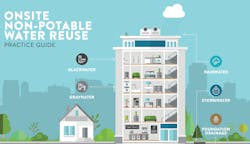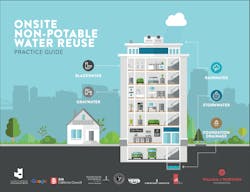Guide to Onsite Non-Potable Water Reuse
Earlier this year, in response to the growing global concern for reduced future water resources, a broad coalition of West Coast corporations, industry foundations and governmental agencies jointly published the Onsite Non-Potable Water Reuse Practice Guide for architects and engineers. Determined to make the best use of existing resources, the guide's stated goal is "to make the design, value and benefits of cost-effective integration of onsite water reuse systems a core competency for architects and engineers. A working group of subject matter and industry experts was convened to develop the content for this guide and infographics, and to validate technical resources for water use and reuse."
Below is a brief introduction to the 87-page report, which can be downloaded in full here.
The Onsite Non-Potable Water Reuse Practice Guide was written with practicing architects and other building design professionals in mind. It provides simple and powerful explanations of why you may want to consider whether non-potable water reuse makes sense for your commercial or residential project. It also offers easily accessible information and next steps for how to incorporate systems in project design and maximize their value.
NON-POTABLE WATER REUSE || TEN REASONS WHY YOU SHOULD CARE:
- It reduces a building’s need for potable water;
- It extends our water supply;
- It increases the resiliency of our cities and urban neighborhoods;
- It can reduce the costs of expanding and upgrading water and sewage infrastructure;
- It can allow projects to better achieve green building certifications without altering the architectural design;
- When done right, it is safe, cost-effective, and publicly acceptable;
- It can be a cost-effective strategy to move your project closer to net-zero energy and water use;
- It can be used as a tool to shorten planning and entitlement reviews;
- Understanding how to address the water-energy nexus in practice is a great way to demonstrate professional leadership and environmental stewardship;
- Eventually, onsite non-potable water reuse will be allowed and may be required in your jurisdiction.
Most people do not realize that most of the water used in buildings does not need to be potable. For instance, many would say flushing our toilets with drinking water is a “waste.” In fact, 95% of water used in commercial buildings and 50% of water used in multi-family residential buildings is for non-drinking water needs.
The non-potable water associated with buildings—rainwater, stormwater, and wastewater—has traditionally been considered either too expensive or too dirty to reuse, but that is not necessarily the case. This water, which is typically collected and carried away from the buildings we design, can be treated onsite to a level of quality that makes it safe to use again immediately for specific, dedicated purposes. Onsite treatment is cost-effective and safe and has proven effective in meeting water quality standards while reducing the need for potable water and the energy consumed in its delivery. Onsite treatment uses similar principles and technologies that have been used to treat water/wastewater in our municipal systems for decades.
The Future of Water is Flexibility
The future of our cities and communities will not rely solely on traditional, centralized infrastructure, but rather on an integration of centralized and decentralized approaches that maximizes the advantages of different systems to make our water supplies reliable and adaptable.
Onsite non-potable treatment and reuse play an important role in this approach. Incorporating decentralized treatment systems into buildings can increase the efficient use and reuse of water, reducing the amount of potable water used unnecessarily. In turn, recycling water onsite decreases the significant energy consumption needed to pump water long distances between treatment plants and users and may also offer heat recovery opportunities.
Furthermore, onsite systems can help alleviate stress on existing, burdened infrastructure. By diverting flows, the lifespan of pump stations and treatment facilities can be extended, maintenance and municipal energy costs can be reduced, and capacity can be utilized elsewhere. When considering an onsite solution, it is important to recognize that project savings are often greater than the impacts of lost revenue related to the diverted flows.
Water Reuse is a Design Opportunity
By designing buildings with non-potable onsite water reuse, architects and other building design professionals, developers, and others in the industry can support a larger shift within our communities to build and manage a more resilient, equitable system.
Thinking holistically about a project provides the opportunity to develop a strategy that utilizes alternative water sources available to the project in innovative, cost-effective ways to meet non-potable demands. Non-potable onsite water reuse is a new way of thinking based on established, proven technologies and treatment processes. It is an important component of a larger, "One Water" approach to managing, treating, and maintaining our precious water resources. As an innovative approach to resource conservation, onsite water reuse is indeed a design opportunity.
##########
For much more, including best practices, multiple case studies and detailed cost analyses, click here.
This research was led by The Charles Pankow Foundation, Google, Magnusson Klemencic Associates, AIA California Council, Water Environment & Reuse Foundation, and The William J. Worthen Foundation.


